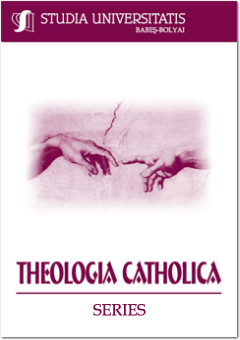SUNT RĂNITĂ DE IUBIRE. DORINŢA NEPOTOLITĂ A MIRESEI DUPĂ MISTICA UNIRE CU MIRELE EI LA SFÂNTUL GRIGORIE DE NYSSA, IN CANTICUM CANTICORUM
I AM WOUNDED BY LOVE. THE BRIDE'S INSATIABLE DESIRE FOR MYSTICAL UNION WITH HER GROOM IN ST. GREGORY OF NYSSA'S IN CANTICUM CANTICORUM
Author(s): Liviu PetcuSubject(s): Christian Theology and Religion
Published by: Studia Universitatis Babes-Bolyai
Keywords: bride; insatiable desire; union; groom; wounded by love; Gregory of Nyssa; apophatic theology; Trinity; Song of Songs.
Summary/Abstract: I am wounded by love. The bride's insatiable desire for mystical union with her groom in St. Gregory of Nyssa's In Canticum Canticorum. One of the more intriguing exercises contained in the Song of Songs features Gregory's highly provocative triptych of the wound of love in Homilies Four, Twelve and Thirteen. In the most extended treatment of his theme, Homiliy Four features the arrow as an explicitly Trinitarian image. The archer is love (ἀγάπη), later identified as God, and the arrow itself is the only begotten Son. The tip of the arrow (faith) is triple-pointed, dipped and moistened in the Spirit. The bride cries out, “I am wounded by love” and is immediately immersed in an apophatic context indicated by oxymoronic expressions and images of union. The use of oxymoron, such as “beautiful wound” and “sweet blow” is a favorite figure of speech which the Cappadocian uses throughout the Homilies. It is a key literary expression of his apophatic theology, which serves to point to a union beyond the grasp of discursive reason. Here the union is expressed in the language of the indwelling of the Trinity. This description of union is extraordinary indeed, as the bride is taken into the dynamism of the Trinity. In an understated logophatic gesture, the bride then addresses the daughters of Jerusalem. This manifestation effects profoundly the bride's companions.
Journal: Studia Universitatis Babes Bolyai - Theologia Catholica
- Issue Year: 56/2011
- Issue No: 1
- Page Range: 79-95
- Page Count: 17
- Language: Romanian

